Webhook
Webhook offers an easy way of sending event based data about abandoned carts to applications like Make (former Integromat), Pabbly, Zapier or other. It is a great way for building powerful automations and advanced marketing processes. Please follow this guide to learn about CartBounty webhook and see examples on how to connect it with applications that support webhooks.
- Webhook basics
- Send abandoned carts to Make
- Send abandoned carts to Pabbly
- Enable coupons
- Exclusions
1. Webhook basics
Simply speaking, webhook works like a bridge between two applications helping to deliver messages using a unique webhook URL. Webhook was introduced in CartBounty 9.9 and it can push various abandoned cart events to third-party services. CartBounty includes the following webhook triggers:
- New abandoned cart
- Abandoned cart updated
- Abandoned cart turned into order
- Abandoned cart deleted
Abandoned cart data is sent in JSON format. If multiple abandoned cart items must be sent, they will be sent as an array combined into a single message to save server resources and maximize website speed. All webhook messages use
POSTmethod except abandoned cart deletion which usesDELETEmethod. If you require to change these methods, please use our filters.
2. Send abandoned carts to Make
Make (former Integromat) is an awesome 🤩 automation platform. Besides the huge number of apps that can be connected using Make, it is also one of the easiest to start with. Very user friendly design and clear automation creation process. Please follow this guide to start sending abandoned cart data from CartBounty to Make.
- Sign in to Make
- Navigate to Data stores
- Choose to add a new Data store and provide a name for the storage (this is where all abandoned carts will be stored)
- Create data structure by defining columns you would like to have in your abandoned cart table
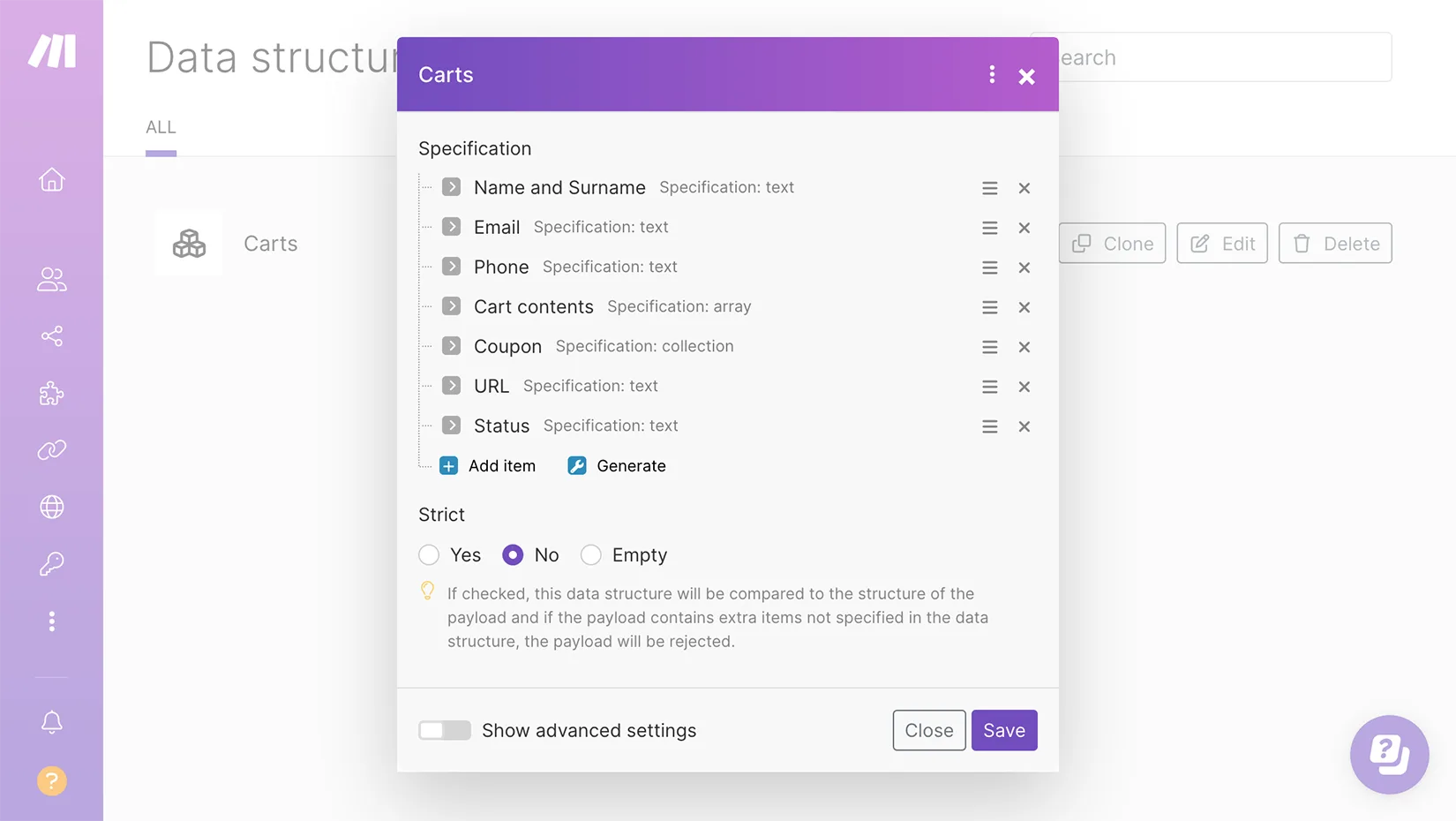
- Navigate to Scenarios and create a new scenario
- Start by adding a new Webhook module
- Choose Custom webhook option
- Create an New hook

- Copy generated webhook URL to clipboard
- Go to your WordPress dashboard > WooCommerce > CartBounty Pro
- Open Recovery > Webhook
- Paste webhook URL
- Use the “Save settings” button
- Test webhook using “Add cart” button

- Switch back to Make scenario
- Run scenario and choose to Process existing message
- You should be able to see a notice next to webhook module containing information about previously sent abandoned cart test data. If test data is not there, please try sending test data from CartBounty again

- Continue building scenario by adding a new Router module
- Create two routes
- Click on the first route and setup a filter
- Name this filter as “Add / Update cart” so that later it is easier to distinguish between both routes
- Setup two conditions for this route – continue going forward this route if cart status equals “abandoned” or “ordered”

- Now add a new Data store module at the end of first route
- Select “Add / Replace a record” from provided Data store options
- Select Data store option from the list that was created in an earlier step
- Set “id” as the key which will serve as a unique identifier and will be important when updating abandoned cart
- Choose to overwrite an existing record (this is used to update abandoned cart data in case it is turned into a new order or cart data has been updated)
- Map all fields with appropriate values from the abandoned cart test data and save the changes
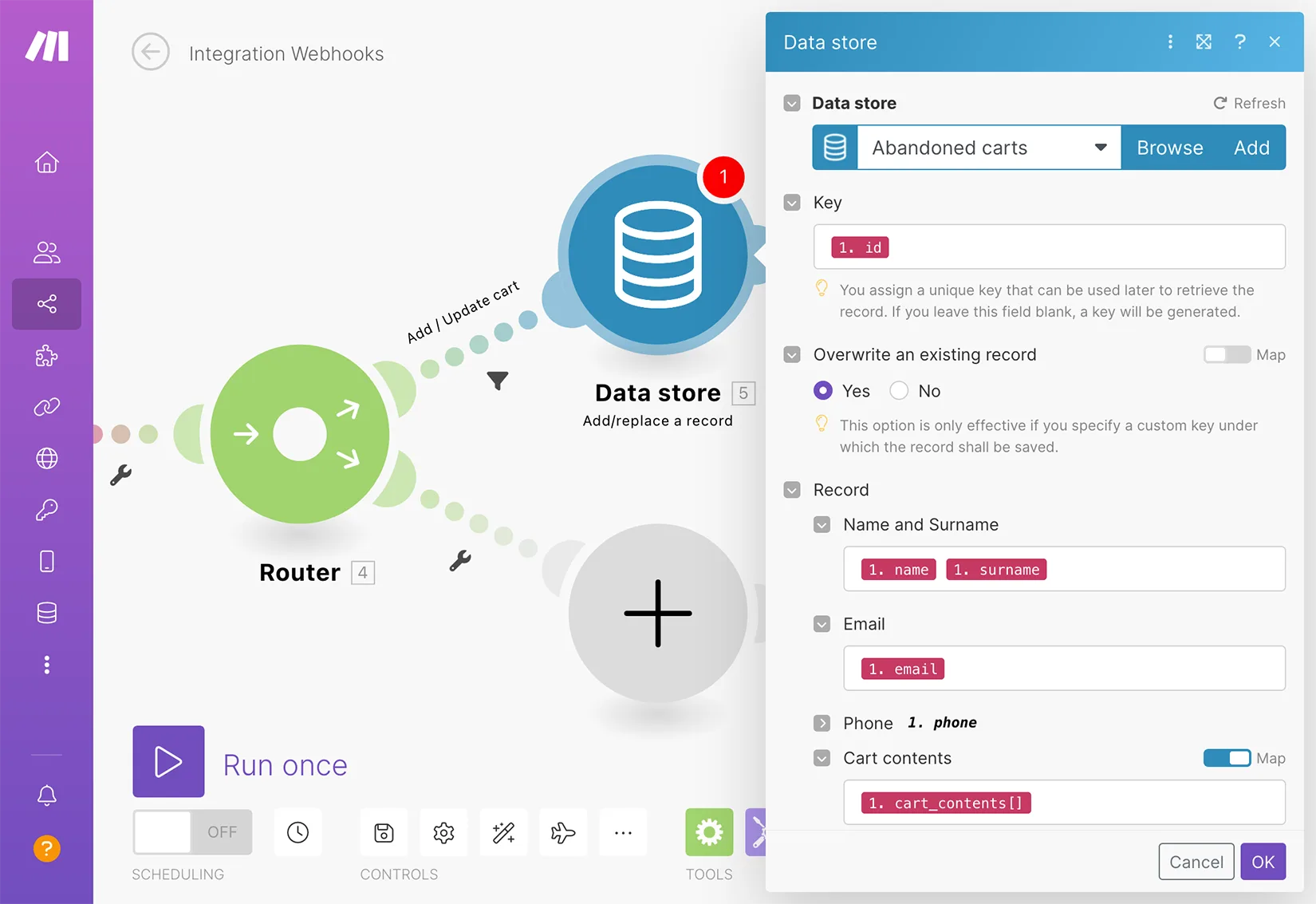
- First route is done, now we can continue with the second one which will handle abandoned cart deletion
- Click on the second route and setup a filter
- Name this filter as “Delete cart”
- Setup one conditions for this route – continue going forward this route if cart status equals “deleted”

- Now add a new Data store module at the end of second route
- Select “Delete a record” from provided Data store options
- Select Data store option from the list that was created in an earlier step
- Set “id” as the key which will be used to identify the cart that should be deleted

- Save your scenario
- Start running your scenario and try testing all routes by sending test abandoned cart data from CartBounty to check if your Data storage displays abandoned cart updates

These are the basic steps required to get abandoned carts from your WooCommerce store using CartBounty webhook into Make. From here your options are endless – you can create a new automation which uses abandoned cart data stored inside Data store to send reminder messages (SMS, Email, WhatsApp), add customers to your CRM, send custom stats about abandonment to Google Analytics etc.
3. Send abandoned carts to Pabbly
Pabbly supports more than 1000+ applications for creating powerful automations and seamless real-time data transfers at a competitive price. It provides an intuitive workflow building process as well as simple and user friendly interface. Please follow this guide to start sending abandoned cart data from CartBounty to Pabbly and store them inside a Google sheet.
- Sign in to Pabbly
- Open Pabbly Connect
- Start by creating a new workflow
- Provide a name for this workflow e.g. “Abandoned carts”
- Choose Webhook as the starting trigger
- Disable “Simple Response”
- Copy generated webhook URL to clipboard

- Go to your WordPress dashboard > WooCommerce > CartBounty Pro
- Open Recovery > Webhook
- Paste webhook URL
- Use the “Save settings” button
- Test webhook using “Add cart” button

- Sign in to Google Drive
- Now it is time to setup spreadsheet for storing abandoned carts that will be sent to Pabbly. Create a new spreadsheet
- Use first row of the new sheet to create column headers for data you would like to store
- Save your spreadsheet

- Switch back to Pabbly workflow
- Continue building automation workflow by adding a new Iterator action. This will make sure whenever CartBounty sends multiple abandoned cart items in one message, they will all get properly handled
- Select “Response[]” in the Choose Array field
- Click on the “Save and test request” button. You should be able to see previously sent abandoned cart test data. If test data is not there, please try sending test data from CartBounty again
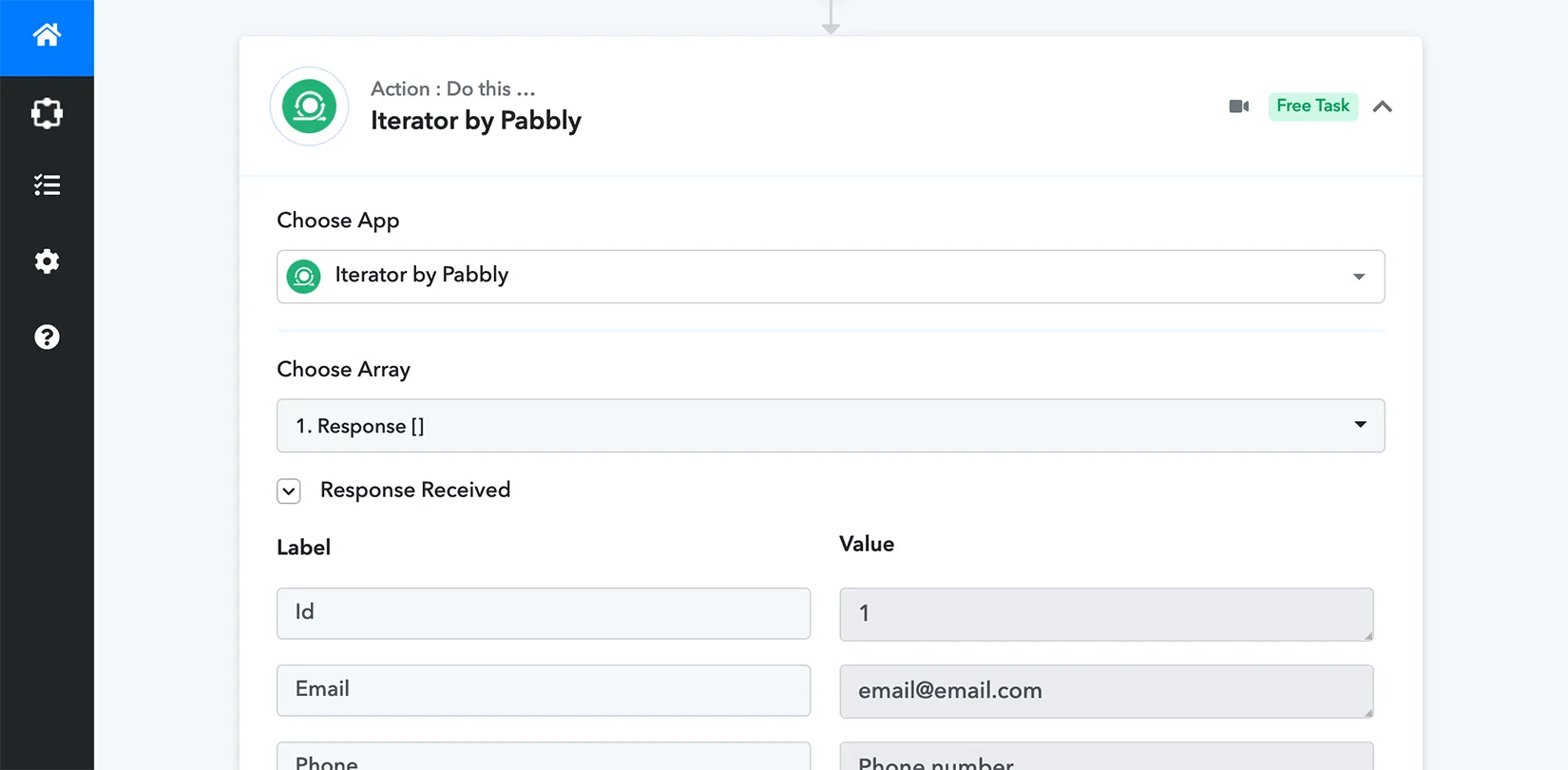
- Continue building automation workflow by adding a new Router action
- Add additional route so you would have a total of 3 routes inside Router element
- Rename your first route to “Add new cart”
- Click on the “Set Filter & Action Steps” button of “Add new cart” route
- Setup condition for this route – continue if cart status equals “abandoned” and last synced value is “0000-00-00 00:00:00”
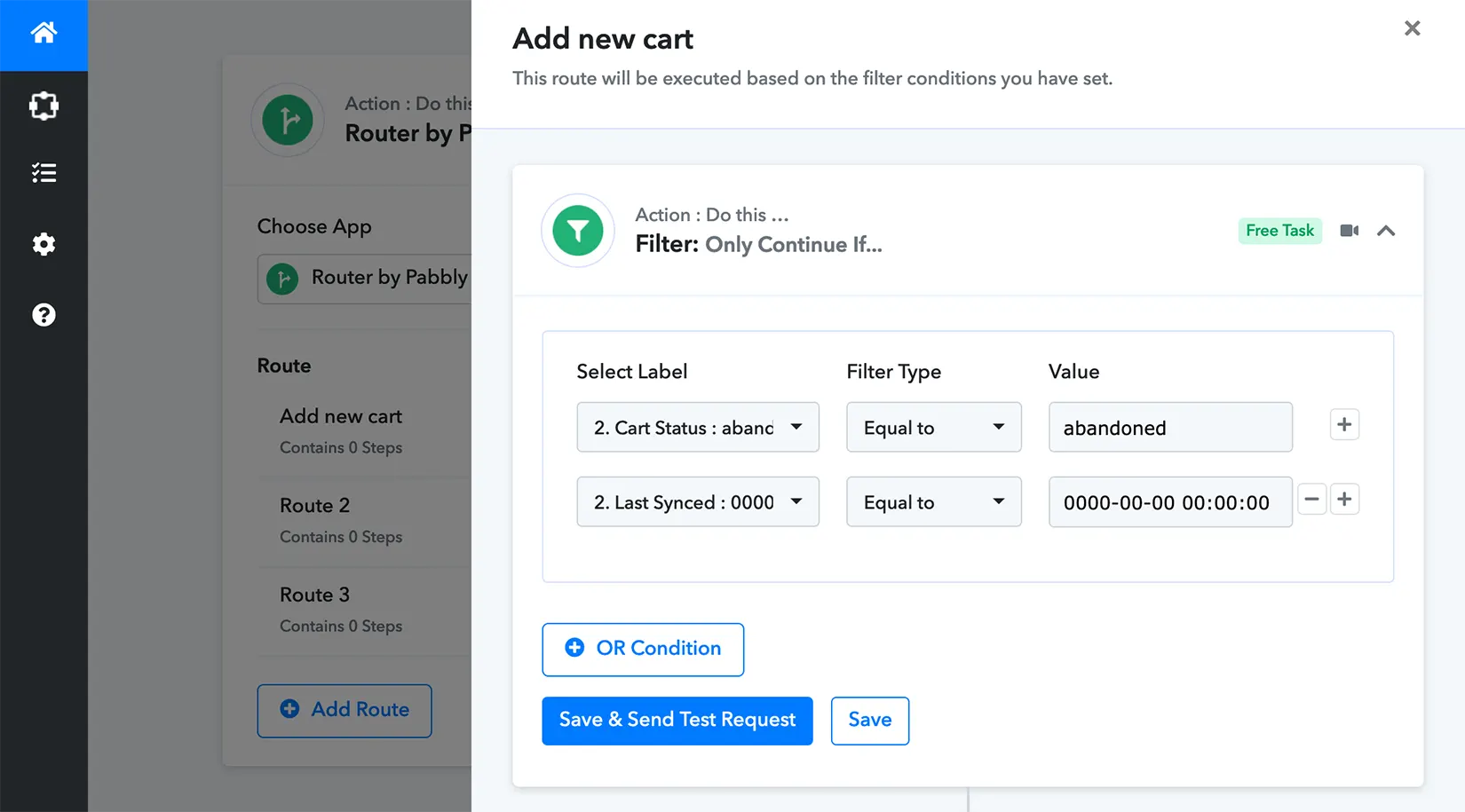
- Save filter
- Continue building “Add new cart” route by adding a new Google Sheets action step
- Set action event to “Add New Row”
- Connect Google sheets account and authorize application
- Select Google spreadsheet that was created earlier in Google Drive
- Map all fields with appropriate values from the abandoned cart test data and save the changes. First route is complete – you can close it

- Rename the second route of Router element to “Update cart”
- Click on the “Set Filter & Action Steps” button of “Update cart” route
- Setup two conditions for this route – continue if cart status equals “abandoned” and last synced value is not “0000-00-00 00:00:00” or if cart status equals “ordered”
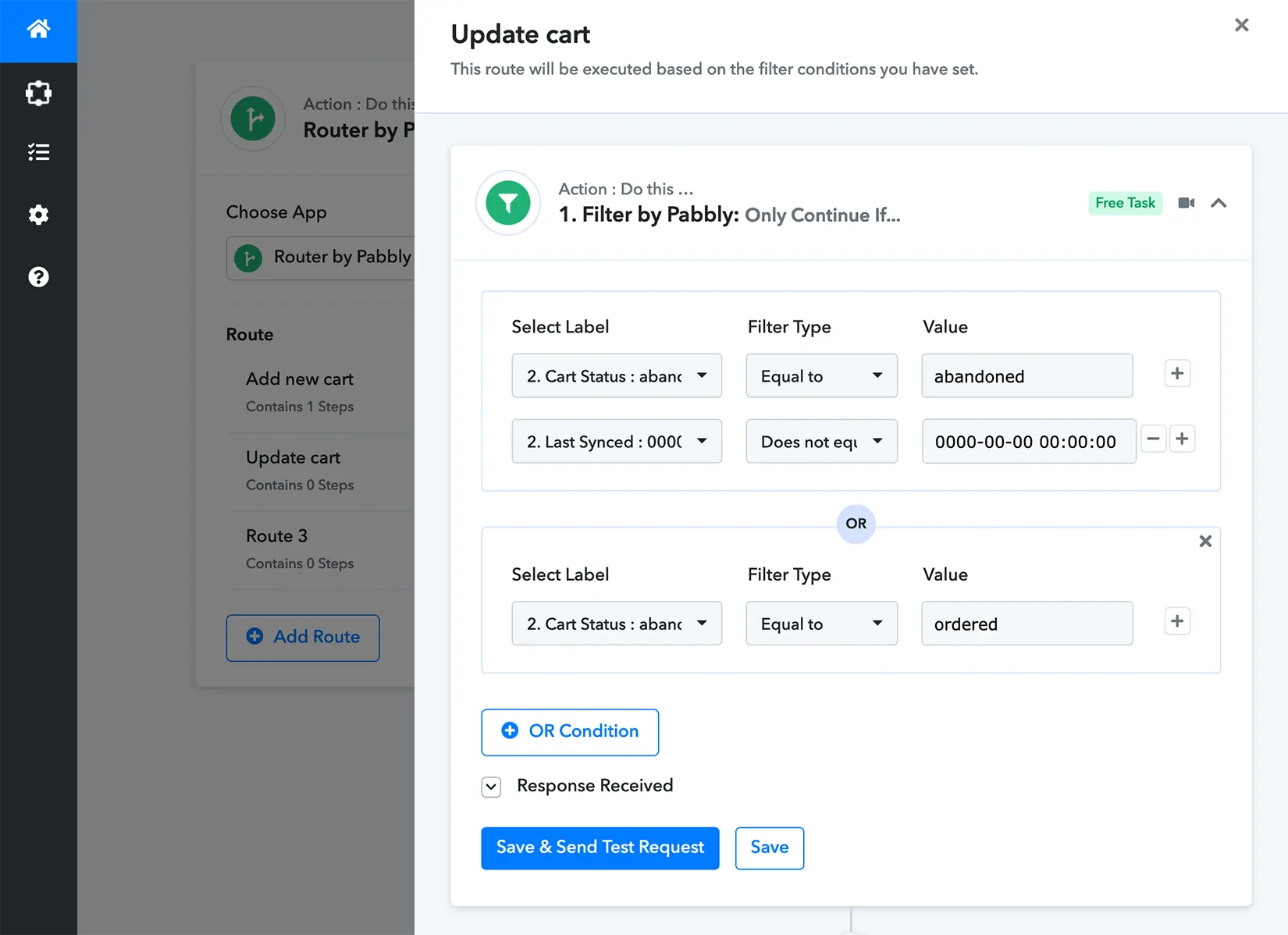
- Save filter
- Continue building “Update cart” route by adding a new Google Sheets action step
- Set action event to “Lookup Spreadsheet Rows”
- Connect Google sheets account and authorize application
- Select Google spreadsheet that was created earlier in Google Drive
- In the Lookup Column enter “A” (Pabbly will search in the first column where abandoned cart ID values are stored)
- Choose Lookup value from abandoned cart test data – “Id”
- Click on the “Save and test request” button. You should be able to see that one abandoned cart has been found with additional information fields displayed. If you get a result that no row was found, please make sure your Google sheet spreadsheet has abandoned cart test row saved inside it
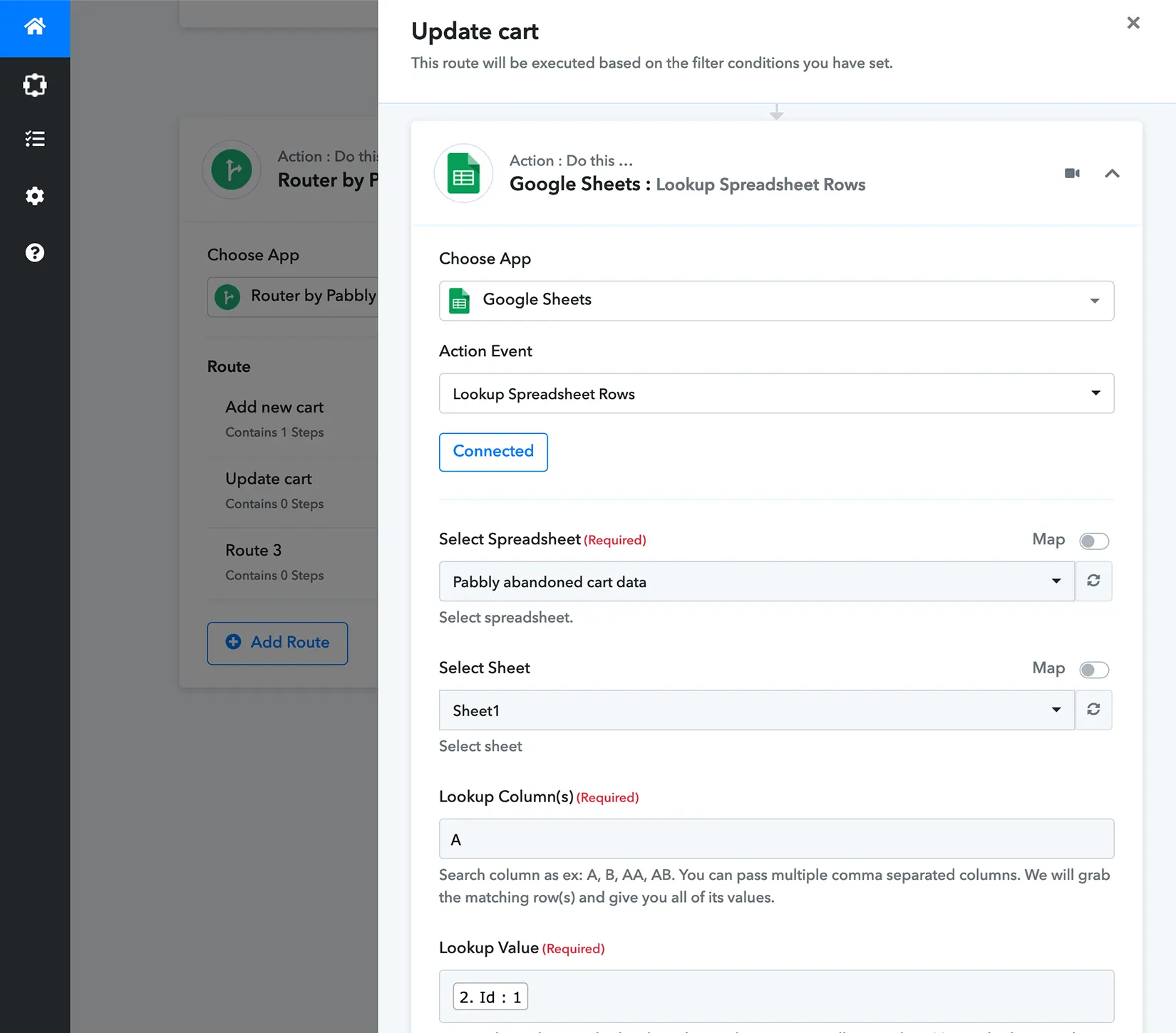
- Save current action step
- Continue building “Update cart” route by adding a new Google Sheets action step
- Set action event to “Update row”
- Connect Google sheets account and authorize application
- Select Google spreadsheet that was created earlier in Google Drive
- Choose Row Index value returned from the previous Lookup step – “RowIndex”
- Map remaining fields with appropriate values from the abandoned cart test data
- Save current action step. Second route is complete – you can close it
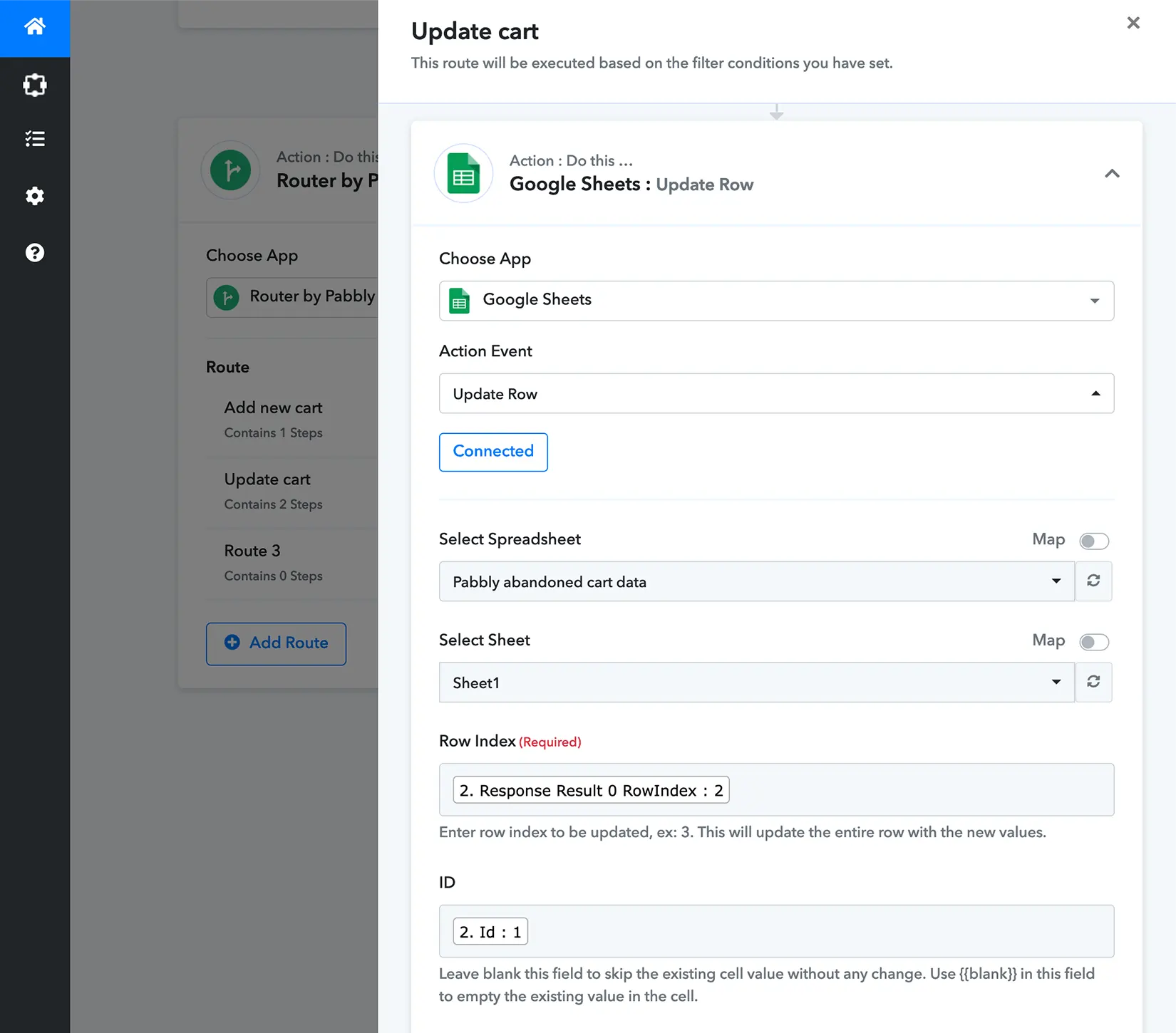
- Rename the third and last route of Router element to “Delete cart”
- Click on the “Set Filter & Action Steps” button of “Delete cart” route
- Setup condition for this route – continue if cart status equals “deleted”
- Save filter
- Continue building “Delete cart” route by adding a new Google Sheets action step
- Set action event to “Lookup Spreadsheet Rows”
- Connect Google sheets account and authorize application
- Select Google spreadsheet that was created earlier in Google Drive
- In the Lookup Column enter “A”
- Choose Lookup value from abandoned cart test data – “Id”
- Click on the “Save and test request” button. You should be able to see that one abandoned cart has been found with additional information fields displayed. If you get a result that no row was found, please make sure your Google sheet spreadsheet has abandoned cart test row saved inside it
- Save current action step
- Continue building “Delete cart” route by adding a new Number Formatter action step
- Set action event to “Perform Math Operation”
- In the Numbers field choose “RowIndex” returned from previous Lookup step. Then add a comma followed by number “1” (this is Pabbly syntax of dealing with numbers)
- Choose Operation field as “Subtract”
- Click on the “Save and test request” button
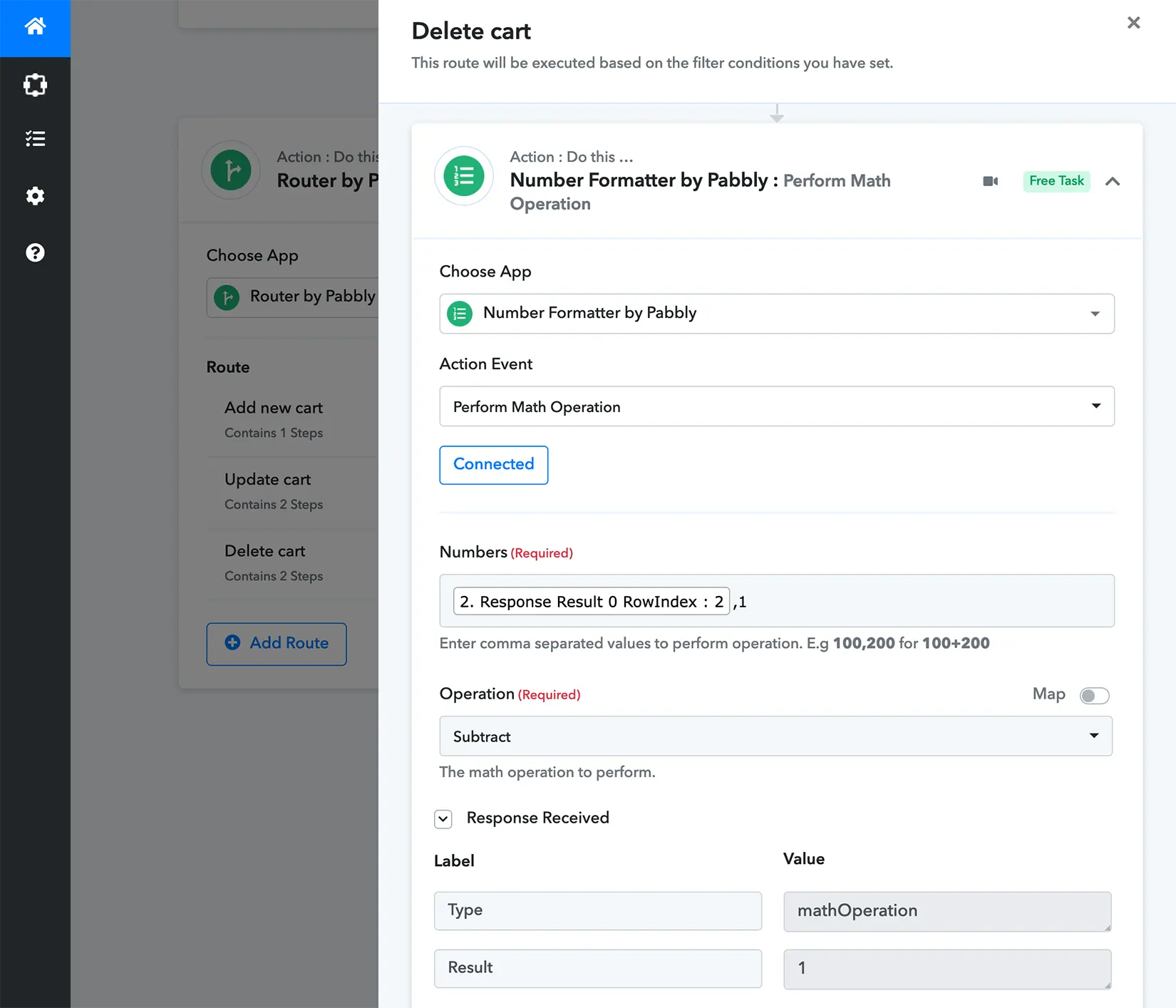
- Continue building “Delete cart” route by adding a new Google Sheets action step
- Set action event to “Delete Row”
- Connect Google sheets account and authorize application
- Select Google spreadsheet that was created earlier in Google Drive
- In the Start Row Number field choose “Result” from previous Number Formatter step
- In the End Row Number field choose “RowIndex” returned from Lookup step

- Save current action step. Third and last route is complete – you can close it
- Try testing all routes by sending test abandoned cart data from CartBounty and check if Google sheets spreadsheet displays abandoned cart rows and updates
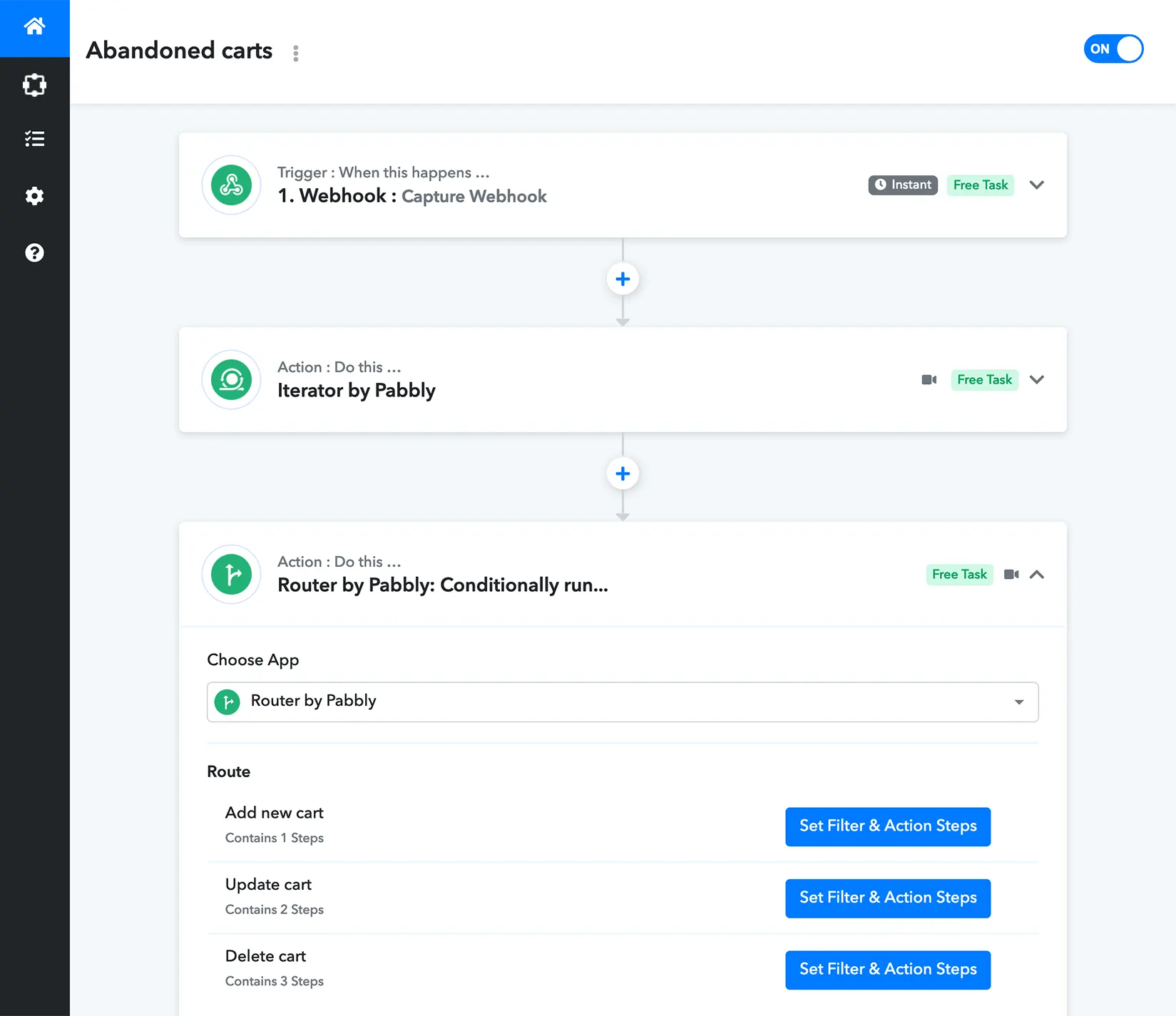
This wraps up all of the basic steps necessary to get abandoned carts from CartBounty into Pabbly using webhook URL. From here you can create a new automation workflow that takes abandoned carts from Google spreadsheet and sends abandoned cart reminder messages etc.
4. Enable coupons
CartBounty allows to include both static and one-time generated discount codes inside recovery emails to sway users into completing their orders. To enable coupons, please start by configuring coupon code inside CartBounty and then it will be automatically included in abandoned cart data sent to webhook.
- Go to your WordPress dashboard > WooCommerce > CartBounty Pro
- Open Recovery > Webhook
- Choose to generate a unique coupon code for each abandoned cart user or select an existing coupon code from the list that will be sent to eligible abandoned carts
- Setup Usage restrictions if necessary
- Use the “Save settings” button
Abandoned cart users who are not eligible for the coupon code will not receive it. If a user clicks the abandoned cart recovery link, the coupon code will be automatically applied.
5. Exclusions
Exclusions block allows an easy way to exclude carts from abandoned cart recovery containing specific products or product categories. If any of the excluded products or product categories is found inside the cart, CartBounty will automatically exclude this cart from recovery.

What’s next
You have learned how to use CartBounty webhook and transfer abandoned cart data to external systems that support it. You might also be interested in the following topics:
- How to send effective abandoned cart recovery emails
- Get new leads and increase sales using Exit Intent popup
- Increase recoverable carts and sales with “Add to cart” popup
- Lower cart abandonment using dynamic browser Tab notification
- Send push notifications to recover abandoned carts
- How to use abandoned cart reports and analytics to increase sales
